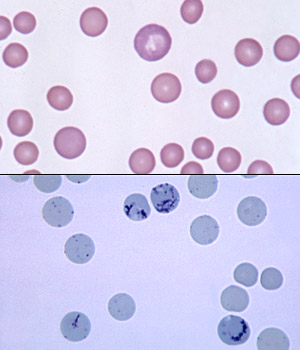
|
Upper panel: Polychromatophilic RBCs in regenerative anemia in a cat.
Lower panel: Aggregate and punctate reticulocytes stained with NMB from
the same cat.
|
Feline reticulocytes:
There are two types of RNA-containing red cells in cat blood. The
aggregate reticulocytes are red cells with clumps of blue-stained
granules and the punctate reticulocytes are red cells with fewer,
smaller blue granules. The aggregate reticulocytes mature into
punctate reticulocytes within 12-24 hours; punctate reticulocyte circulate for at
least several days (7-10 days) before all the RNA is lost. The reticulocyte
count in cat blood should only include the percentage of aggregate reticulocytes;
punctate reticulocytes are not counted as they do not reflect the most recent bone marrow response (e.g. an anemic cat with only punctate reticulocytes is not actively regenerating at this time, but has shown some bone marrow regeneration in the past 7-10 days).
At normal hematocrits, few reticulocytes are released
at the aggregate stage. Non-anemic cats have only 0 to 1%
aggregate reticulocytes but may have as high as 10% punctate
reticulocytes. With moderate to severe anemia due to blood
loss or hemolytic disease, the healthy cat marrow increases
the rate of erythropoiesis and releases aggregate reticulocytes,
thereby raising the reticulocyte count. Since only aggregate
reticulocytes are included in the count, the result is a fairly
good indicator of the degree of the present marrow regenerative
response. Note that in mild anemias, cats may only release punctate reticulocytes.
The following table is a guide to the expected reticulocyte
counts for cats with regenerative response to anemia: |
